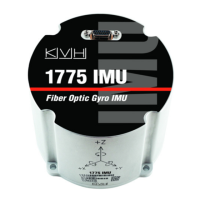This document contains proprietary information of KVH Industries, Inc. and neither this document nor said proprietary information shall be
published, reproduced, copied, disclosed, or used for any purpose without the express written permission of a duly authorized KVH representative.
Page 71 of 77
When there is a need to provide on-demand, real-time output with minimal data latency,
there are limits to using some of these techniques, which forces some compromises. For
example, we use cascaded biquad (IIR) stages rather than wide FIR filtering to simplify
processing burden and achieve steep anti-alias roll-off, but this sacrifices phase shifting
resulting in frequency-specific distortion that an application might not tolerate.
When we use the term “arbitrary” in “arbitrary sample rate conversion,” we mean that the
output sample rate may be different (asynchronous) from the input sample rate and possibly
non-uniform in time (non-isochronous) with respect to itself. Specifically, in our system the
output can be configured to a repeatable rate (isochronous) driven by an internal timer or on-
demand (arbitrary and non-repeatable) driven by the user-interface. Where our output rate is
isochronous, it is not an integer multiple or ratio of the internal data sampling rates of sub-
systems. In fact, internally the sample rates of each gyro and each accelerometer are
separate and unique. Therefore, we cannot simply provide integer downsampled data as an
output.
If the output sampling rate is much less than the input sampling rate (i.e., it is a highly
oversampled system) then it may be sufficient to simply apply a low-pass filter to the input
samples and resample at some other discrete times and accept the added slight jitter.
In the IMU, the user-interface output rates are lower than the internal sampling (input) rates,
but can be in the same order of magnitude, so conversion requires use of some multi-rate
asynchronous arbitrary downsampling. To reduce jitter and uncertainty in the sample rate
conversion, the output value is interpolated using timestamps.
12.2.7 Output Data Interpolation
Arbitrary sample rate conversion involves computing the output sample values based on the
input sample values and the timing relationships of the output to the input. Therefore, by
nature, it is an interpolation process.
One way to think of this would be to interpolate by conversion of the input samples from
discrete/digitized values back to the continuous/analog domain and then filtering and re-
digitizing at the new output rate. This would be analog interpolation. We can also use purely
discrete time algorithms to interpolate the input samples to generate new output data values
by constructing a model of the behavior of the signal based on nearby samples. The IMU
uses simple linear interpolation whereby a percentage of the prior sample mixed with a
complementary percentage of the latest sample is used for the output. Thus, the interpolation
model used between the samples is a straight line.
For the 1750 IMU and 1775 IMU, the interpolation algorithm uses the last two internal data
points along with their timestamp information to derive the output value. While this adds a
single internal sample rate period of latency, it provides a more accurate output value, with
less jitter and uncertainty than a simple sample-and-hold output based on the most recently
available internal data. A better description of the operation of the interpolation algorithm
follows.

